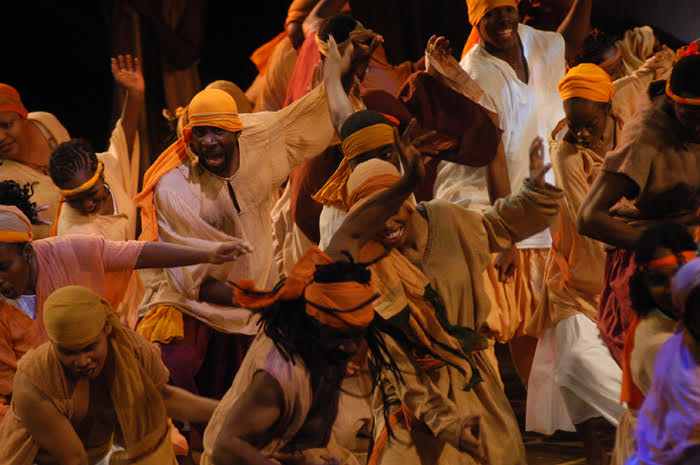Following her summer of research, investigating why this explosion of culture and vision is so important, Anna May tells us more about Carnival Messiah preceeding its showing tomorrow at West Yorkshire Playhouse.
When I applied to do a summer research project on ‘The Impact and Legacy of Carnival Messiah’, I never imagined where it would take me. From being mic’d up to interview world class opera singers, to drinking tea with the Earl of Harewood, to spending an evening freestyling to Caribbean dancehall music with a group of strangers, I have been awed and inspired at every turn. After six weeks work I can safely say there is no simple way to describe Carnival Messiah, but I’ll do my best.
Carnival Messiah was the pinnacle of Geraldine Connor’s artistic career, both an exceptional piece of theatre and a politically charged platform for social and personal transformation. With its beginnings as a student project in the 90s at Bretton Hall (now the university’s drama department) and developing into a huge scale professional production with performances in Leeds, London, and Trinidad, it has now been seen by over 750,000 people across the globe. Geraldine herself described it as a ‘spectacular musical showcase, featuring a multi-ethnic multitude of singers, musicians, masqueraders, dancers and actors […] the excitement, music and colour of Carnival blended with Handel’s most inspiring and exhilarating melodies’. The classical Christian story presented in an explosion of global art forms, it sounds bizarre and chaotic, and in many ways it was, but it worked.
Carnival Messiah was a dazzling spectacle that received standing ovation from audiences night after night, but it was also deeply enlightening and transformative. Carnival Messiah was embedded with history and politics. It aimed to educate the diverse community of Leeds about its rich multicultural heritage, with a focus on Caribbean culture, looking at themes such as the migrant experience, the meaning of Carnival, and the history of the slave trade. Geraldine was concerned by the harmful divisions in our society, by the way cultural difference was being exploited for conflict and exclusion, rather than celebration and unity. She saw Carnival Messiah as a way to approach these issues in a non-confrontational way, while helping each participant to develop professional and life skills at the same time. Through art, Geraldine created a platform for empowerment, equality, and hope, and paved the way to space of ‘safety and well-bring where all can co-exist in love, peace and harmony’.
‘The classical Christian story presented in an explosion of global art forms, it sounds bizarre and chaotic, and in many ways it was, but it worked.’
Ten years since the last performance at Harewood House, and six years since Geraldine passed away, Carnival Messiah is still alive and kicking. Every single person (and I mean about a hundred of them) who has spoken to me about their experience has seemed buoyed up by some sort of external energy, a sense of truth and joy unique to Carnival Messiah. Each person has been on their own journey, both professional and personal, which continues to impact them even now. Every interaction, the face-to-face interviews, the phone calls, even the emails, have been full of life and taught me a multitude of unexpected lessons about the creative world, but also about the world more generally.
Carnival Messiah is the perfect example of good art. While drama, dance, music, design and all things visual may be seen primarily as a creative outlet, a source of entertainment, or a showcase of talent, we must not forget the powerful potential to enrich and transform people’s lives. More than anything, this is what art is, and this is what we should be striving for.
The film of Carnival Messiah is being Screened at the West Yorkshire Playhouse on Saturday 16th September, and then again as part of Leeds International Film Festival at the town hall on November 7th.
Anna May
(Image courtesy of Lorne Campbell/Guzelian)

